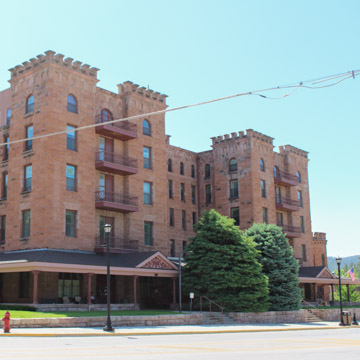In 1881, five men who arrived in the Black Hills during the late 1870s gold rush created the Hot Springs Town-Site Company with the intention of developing a resort in an area with more than 75 warm water, mineral-rich springs. As physician-prescribed treatments for mineral water baths increased in the late nineteenth century, the town of Hot Springs flourished.
The person most closely associated with the growth and success of the Hot Springs spa industry is Fred T. Evans, who, in 1886, became president of the newly reorganized Hot Springs Town-Site Company, now known as the Dakota Hot Springs Company. That year, the company built the two-story Minnekahta Hotel, and by the time the town incorporated in 1890, there were a number of bathhouses. The 1890 arrival of the railroad insured continued success for the resort area. When the Minnekahta Hotel burned to the ground in 1891, Evans constructed a new hotel on the site.
The five-story Evans Hotel has an H-shaped plan and contained more than 200 rooms. Electricity and elevator service were some of the modern amenities offered. The Romanesque Revival building is constructed of pink Lakota sandstone quarried from the nearby Fred Evans Quarry, which operated from the late 1880s until about 1925, and again briefly in the 1930s. Hallmarks of the architectural style include not only the rough-cut sandstone but also the crenellated towers and round-arch openings. The hotel was built over the course of ten months at a cost of more than $300,000. A three-story annex, built in 1892, served as the bathhouse for the hotel.
Sandstone was an abundant building material in western South Dakota between the late 1880s until about 1910. Evans Quarry sandstone was also used to construct the Soldiers and Sailors Memorial Building in Pierre. Several quarries were located in Fall River County, all producing sandstone in pink, gray, and cream colors. Many of the buildings in Hot Springs were constructed with sandstone from these quarries, as were buildings throughout the Black Hills. Additionally, a quarry near Spearfish produced a red-colored sandstone called Sundance stone, used for construction in Spearfish and nearby towns.
The hotel closed in 1974 after a fire resulted in substantial damage. It was converted to senior citizen housing in 1979.














